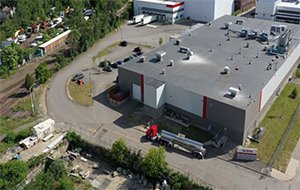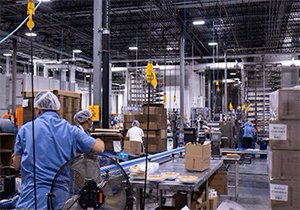R1 Success Story: 25 Southgate Street, Worcester, Mass.

EPA Grant Recipient:
City of Worcester
Grant Types:
Two EPA assessment grants totaling $78,000
Current Use:
Baking Facility
Former Uses:
Steam Engine Manufacturing, Foundry
Download Success Story: 25 Southgate Street, Worcester, Mass. (pdf)
An industrial site used for manufacturing since the 1800s has been cleaned and redeveloped in the South Worcester Industrial Park, providing a 50,000-square-foot new home for a century-old baking company.
The baking company was founded in 1924 by two Greek immigrants who began by selling pies from horse-drawn carts on the streets of Worcester. That company, which was family-owned for three generations, is now one of the nation's largest pie bakeries and occupies a building on an 8-acre industrial park that was made possible by funding from EPA, the state of Massachusetts, and the City of Worcester.
When the company began searching for a new location close to its existing work force, it found an ideal fit in a brownfields site in the South Worcester Industrial Park. The pad-ready industrial park is the result of more than 20 years of effort by the City after it acquired 8 acres of blighted, abandoned properties through tax title foreclosures and friendly acquisition. State and federal grants combined with city funds paid to demolish buildings, conduct environmental response actions, and create a space ready for light industrial redevelopment.
Priming the Property for Redevelopment
A steam engine manufacturing company owned a part of the property in the 1800s. It was later acquired by another company that specialized in manufacturing iron castings that operated for nearly 100 years, including helping to supply the war effort in two world wars. Industrial operations continued at the property until 1984. The City foreclosed on the property in 2004 as part of the creation of the South Worcester Industrial Park.

Concerns over potential contamination from historic manufacturing operations were a significant obstacle to redevelopment. Funding from two EPA Brownfields assessment grants was used to assess the property. In 2007, $47,000 was used to assess the property for hazardous substances. In 2009, $36,000 was used to investigate petroleum contamination. Among the contaminants identified at the site were hydrocarbons, arsenic, and polychlorinated biphenyls, known as PCBs. Underground storage tanks containing fuel oil were also found. The results of environmental assessment, and the quantification of potential liabilities, were key in moving the redevelopment forward.
Based on the information uncovered and site characterization developed through the environmental assessment, additional state, local, and private funds were invested to successfully redevelop the property. MassDevelopment, the economic development arm of the State, provided $100,000 for further assessment and cleanup. Infrastructure and other improvements to the South Worcester Industrial Park were made possible through the Massachusetts' MassWorks Program and a $3 million City bond. The developer invested about $4.5 million in constructing the building, which was then leased by the pie company. City Council members also approved a tax plan for the property that reduces property taxes over 20 years. After the pie company invested about $4 million for equipment, the new facility was ready for production.

Today
"[The company] has deep roots in the City of Worcester and we are pleased to have played a role in facilitating their expansion here in their hometown. The new 50,000 square-foot facility in the South Worcester Industrial Park would not have been possible without the support of the U.S. EPA Brownfields Program and we look forward to continued success and partnership with the EPA in redeveloping brownfields sites across the city."
Edward M. Augustus Jr.
Worcester City Manager
In January 2017, the company also re-opened a neighborhood retail store at its original Green Street location in the Canal District of Worcester. In September of 2017, the company had their grand opening of the newly developed 50,000 square-foot facility on Southgate Street that produces over 52 million snack pies per year.
In recognition of its successful expansion and continued commitment to the City of Worcester, the company received the "Richard B. Kennedy 2017 Business of the Year Award" from the Worcester Regional Chamber of Commerce.
As of 2023, there were 82 new full-time jobs created at the redeveloped facility—in addition to 30 full-time jobs retained— many of which are local to the City of Worcester. The City of Worcester has also used further EPA Brownfields funding to assess and clean up other properties that the pie-baking company currently uses, such as a cold storage facility and a new corporate headquarters.
This brownfields success story resulted from the combined efforts of multiple state, local, federal and private partners committed to cleaning the environment, generating tax revenue, and creating jobs.

For more information:
Visit the EPA Brownfields website at www.epa.gov/brownfields or contact Katy Deng at 617-918-1286 or Deng.Katy@epa.gov.
EPA 901-F-24-003
August 2024
